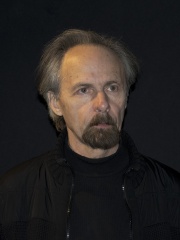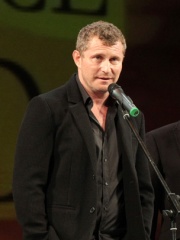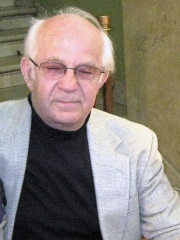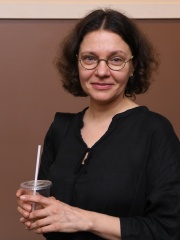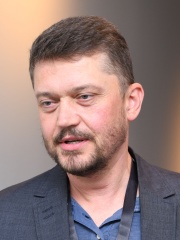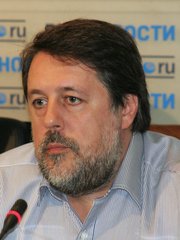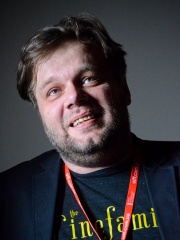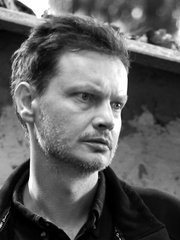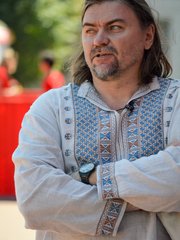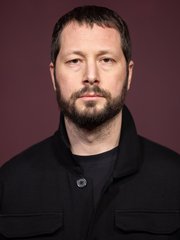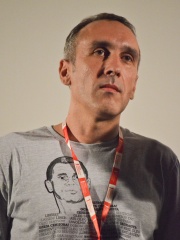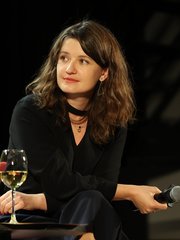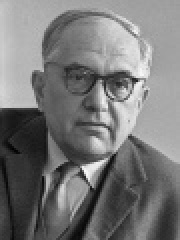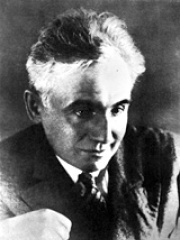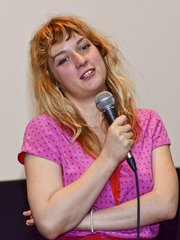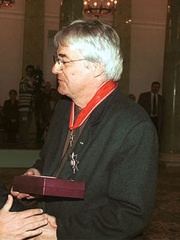
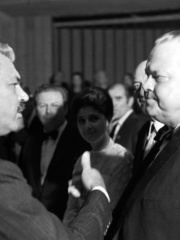
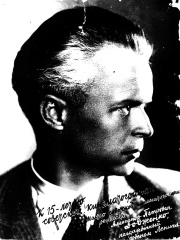
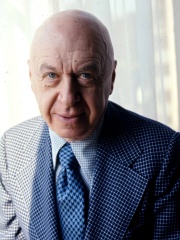
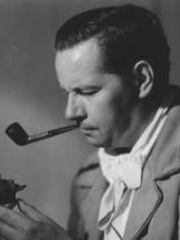
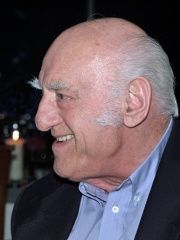
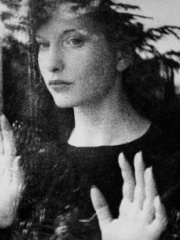
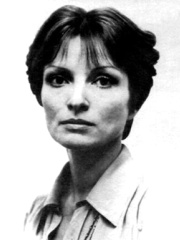
The Most Famous
FILM DIRECTORS from Ukraine
This page contains a list of the greatest Ukrainian Film Directors. The pantheon dataset contains 2,041 Film Directors, 48 of which were born in Ukraine. This makes Ukraine the birth place of the 10th most number of Film Directors behind Japan, and Spain.
Top 10
The following people are considered by Pantheon to be the top 10 most legendary Ukrainian Film Directors of all time. This list of famous Ukrainian Film Directors is sorted by HPI (Historical Popularity Index), a metric that aggregates information on a biography's online popularity. Visit the rankings page to view the entire list of Ukrainian Film Directors.

1. Andrzej Żuławski (1940 - 2016)
With an HPI of 70.90, Andrzej Żuławski is the most famous Ukrainian Film Director. His biography has been translated into 35 different languages on wikipedia.
Andrzej Żuławski (Polish: [ˈandʐɛj ʐuˈwafskʲi]; 22 November 1940 – 17 February 2016) was a Polish film director and writer best known for his 1981 psychological horror film Possession. Żuławski often went against mainstream commercialism in his films, and enjoyed success mostly with European art-house audiences. In the late 1950s, he studied cinema in France. His second feature, The Devil (1972), was banned in communist Poland, and Żuławski went to France. After the success of That Most Important Thing: Love in 1975, he returned to Poland where he spent two years making On the Silver Globe (not released until 1988). The work on this film was interrupted and destroyed by the authorities. After that, Żuławski moved to France where he became known for controversial and violent art-house films such as Possession (1981). Żuławski is also known for his work with actresses including Romy Schneider, Isabelle Adjani and Sophie Marceau. His films have received awards at various international film festivals. Żuławski also wrote several novels, including Il était Un Verger, Lity Bór (a.k.a. La Forêt Forteresse), W Oczach Tygrysa, and Ogród Miłości.

2. Sergei Bondarchuk (1920 - 1994)
With an HPI of 68.99, Sergei Bondarchuk is the 2nd most famous Ukrainian Film Director. His biography has been translated into 55 different languages.
Sergei Fyodorovich Bondarchuk (25 September 1920 – 20 October 1994) was a Soviet and Russian actor and filmmaker of Ukrainian origin who was one of the leading figures of Soviet cinema in the 1950s, 1960s and 1970s. He is known for his sweeping period dramas, including War and Peace (1966-67), his internationally acclaimed four-part film adaptation of Leo Tolstoy's novel, and for Waterloo (1970), a Napoleonic War epic. Bondarchuk's work won him numerous international accolades. War and Peace won Bondarchuk, who both directed and acted in the leading role of Pierre Bezukhov, the Golden Globe Award for Best Foreign Language Film (1968), and the Academy Award for Best Foreign Language Film in 1968. He was made both a Hero of Socialist Labour and a People's Artist of the USSR.

3. Alexander Dovzhenko (1894 - 1956)
With an HPI of 68.69, Alexander Dovzhenko is the 3rd most famous Ukrainian Film Director. His biography has been translated into 52 different languages.
Alexander Petrovich Dovzhenko, also Oleksandr Petrovych Dovzhenko (Russian: Александр Петрович Довженко, Ukrainian: Олександр Петрович Довженко; September 10 [O.S. August 29] 1894 – November 25, 1956), was a Soviet film director and screenwriter of Ukrainian origin. He is often cited as one of the most important early Soviet filmmakers, alongside Sergei Eisenstein, Dziga Vertov, and Vsevolod Pudovkin, as well as being a pioneer of Soviet montage theory.

4. Otto Preminger (1905 - 1986)
With an HPI of 66.12, Otto Preminger is the 4th most famous Ukrainian Film Director. His biography has been translated into 47 different languages.
Otto Ludwig Preminger ( PREM-in-jər; German: [ˈɔtoː ˈpreːmɪŋɐ] ; 5 December 1905 – 23 April 1986) was an Austrian-American film and theatre director, film producer and actor. He directed more than 35 feature films in a five-decade career after leaving the theatre, and was one of the most influential directors in Hollywood during the 1940s and 1950s. He was nominated for three Academy Awards, twice for Best Director and once for Best Picture, among many other accolades. After achieving theatrical prominence in Vienna, Preminger emigrated to the United States in the mid-1930s, working as a director for 20th Century Fox. He first gained attention for film noir mysteries such as Laura (1944) and Fallen Angel (1945), while in the 1950s and 1960s, he directed high-profile adaptations of popular novels and stage works. Several of these later films pushed the boundaries of censorship by dealing with themes which were then taboo in Hollywood, such as premarital sexuality (The Moon Is Blue, 1953), drug addiction (The Man with the Golden Arm, 1955), rape (Anatomy of a Murder, 1959) and homosexuality (Advise & Consent, 1962). He also had several acting roles, most famously as a Nazi POW camp commandant in Stalag 17. Preminger was also notorious for his temperamental and perfectionist attitude on-set, which led to rows with several actors and earned him the nicknames "Otto the Monster" and "Otto the Ogre". Turner Classic Movies wrote that Preminger "enjoyed a long reign in Hollywood as the quintessence of the dictatorial European auteur."
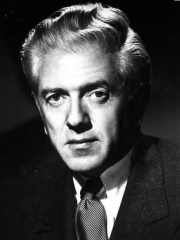
5. Anatole Litvak (1902 - 1974)
With an HPI of 65.78, Anatole Litvak is the 5th most famous Ukrainian Film Director. His biography has been translated into 33 different languages.
Anatoly Mikhailovich Litvak OBE (3 June 1902 – 15 December 1974), commonly known as Anatole Litvak, was a Russian-American filmmaker. Born to Jewish parents in Kiev, he began his theatrical training at age 13 in St. Petersburg, where he lived through the end of the Russian Revolution. He began his film directing career in Germany and France, before moving to the United States in the late 1930s. Litvak was notable for directing little-known foreign actors to early fame and is believed to have contributed to several actors winning Academy Awards. In 1936 he directed Mayerling, a film which made French actors Charles Boyer and Danielle Darrieux international stars. He returned Swedish star Ingrid Bergman to popularity with American audiences in 1956 with Anastasia, in which she won her second Oscar. He directed Olivia de Havilland to an Academy Award nomination for The Snake Pit (1948). He directed Jean Gabin in his screen debut and directed Elia Kazan in his earliest acting role, City for Conquest. Litvak directed Confessions of a Nazi Spy in 1939, starring Edward G. Robinson, which used actual newsreel footage from U.S. Nazi rallies. As a refugee from Nazi Germany, Litvak was among the few directors who tried to open Hollywood's eyes to the threat Germany posed to Europe and the world. During World War II, he enlisted and co-directed documentaries with Frank Capra, including Why We Fight films. On his own he directed The Battle of Russia (1943), which won numerous awards and was nominated for an Oscar. Because of Litvak's ability to speak Yiddish, Ukrainian, Russian, English, German, and French, he supervised the filming of the D-Day Normandy landings. He also filmed aerial warfare with the U.S. Eighth Air Force. He was promoted to full colonel by the end of the war for his volunteer wartime efforts. He received special awards from the governments of France, Britain, and the United States.

6. Richard Boleslawski (1889 - 1937)
With an HPI of 62.73, Richard Boleslawski is the 6th most famous Ukrainian Film Director. His biography has been translated into 19 different languages.
Richard Boleslawski (born Bolesław Ryszard Srzednicki; February 4, 1889 – January 17, 1937) was a Polish theatre and film director, actor and teacher of acting.

7. Jerzy Kawalerowicz (1922 - 2007)
With an HPI of 62.71, Jerzy Kawalerowicz is the 7th most famous Ukrainian Film Director. His biography has been translated into 32 different languages.
Jerzy Franciszek Kawalerowicz (19 January 1922 – 27 December 2007) was a Polish film director, screenwriter and politician, having been a member of Polish United Workers' Party from 1954 until its dissolution in 1990 and a deputy in Polish parliament since 1985 until 1989.

8. Maya Deren (1917 - 1961)
With an HPI of 62.40, Maya Deren is the 8th most famous Ukrainian Film Director. Her biography has been translated into 31 different languages.
Maya Deren (; born Eleonora Derenkovska; Ukrainian: Елеонора Деренковська; May 12 [O.S. April 29] 1917 – October 13, 1961) was an American experimental filmmaker and important part of the avant-garde in the 1940s and 1950s. Deren was also a choreographer, dancer, film theorist, poet, lecturer, writer, and photographer. The function of film, Deren believed, was to create an experience. She combined her expertise in dance and choreography, ethnography, the African spirit religion of Haitian Vodou, symbolist poetry and gestalt psychology (as a student of Kurt Koffka) in a series of perceptual, black-and-white short films. Using editing, multiple exposures, jump-cutting, superimposition, slow-motion, and other camera techniques to her advantage, Deren abandoned established notions of physical space and time, innovating through carefully planned films with specific conceptual aims. Meshes of the Afternoon (1943), her collaboration with her husband at the time, Alexander Hammid, has been one of the most influential experimental films in American cinema history. Deren went on to make several more films, including but not limited to At Land (1944), A Study in Choreography for Camera (1945), and Ritual in Transfigured Time (1946), writing, producing, directing, editing, and photographing them with help from only one other person, Hella Heyman, her camerawoman.

9. Larisa Shepitko (1938 - 1979)
With an HPI of 62.37, Larisa Shepitko is the 9th most famous Ukrainian Film Director. Her biography has been translated into 30 different languages.
Larisa Yefimovna Shepitko (Russian: Лари́са Ефи́мовна Шепи́тько, Ukrainian: Лариса Юхимівна Шепітько, romanized: Larysa Yukhymivna Shepitko; 6 January 1938 – 2 July 1979) was a Soviet film director and screenwriter of Ukrainian origin. She is considered one of the best female directors of all time, with her film The Ascent being the second film directed by a woman to win a Golden Bear and the third film directed by a woman to win a top award at a major European film festival (Cannes, Venice, Berlin). Shepitko was also considered one of the most prominent Soviet filmmakers during both the Khrushchev Thaw and the Era of Stagnation. The Khrushchev Thaw was a direct response to the limitations that were forced upon Soviet citizens during Stalin's reign, and essentially marked the inception of an innovative return to the cinematic arts. Shepitko's career was cut short in 1979 when she was killed in a car accident while scouting locations for the film Farewell. Her husband Elem Klimov created a 20-minute tribute documentary called Larisa to honor her legacy.
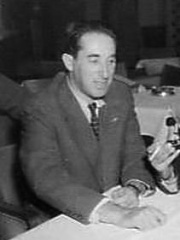
10. Grigori Kozintsev (1905 - 1973)
With an HPI of 60.56, Grigori Kozintsev is the 10th most famous Ukrainian Film Director. His biography has been translated into 31 different languages.
Grigori Mikhailovich Kozintsev (born Grigori Moiseyevich Kozintsov;22 March [O.S. 9 March] 1905 – 11 May 1973) was a Soviet theatre and film director, screenwriter and pedagogue. He was named People's Artist of the USSR in 1964. In 1965 he was a member of the jury at the 4th Moscow International Film Festival. Two years later he was a member of the jury of the 5th Moscow International Film Festival. In 1971 he was the president of the jury at the 7th Moscow International Film Festival.
People
Pantheon has 48 people classified as Ukrainian film directors born between 1885 and 1989. Of these 48, 15 (31.25%) of them are still alive today. The most famous living Ukrainian film directors include Konstantin Lopushansky, Vadim Perelman, and Jerzy Antczak. The most famous deceased Ukrainian film directors include Andrzej Żuławski, Sergei Bondarchuk, and Alexander Dovzhenko. As of April 2024, 8 new Ukrainian film directors have been added to Pantheon including Vitaly Mansky, Ihor Podolchak, and Oles Sanin.
Living Ukrainian Film Directors
Go to all RankingsKonstantin Lopushansky
1947 - Present
HPI: 55.04
Vadim Perelman
1963 - Present
HPI: 54.26
Jerzy Antczak
1929 - Present
HPI: 52.78
Olena Demyanenko
1966 - Present
HPI: 49.48
Valentyn Vasyanovych
1971 - Present
HPI: 48.83
Vitaly Mansky
1963 - Present
HPI: 48.39
Myroslav Slaboshpytskyi
1974 - Present
HPI: 47.38
Ihor Podolchak
1962 - Present
HPI: 46.55
Oles Sanin
1972 - Present
HPI: 43.94
Mstyslav Chernov
1985 - Present
HPI: 43.84
Volodymyr Tykhyi
1970 - Present
HPI: 42.65
Iryna Tsilyk
1982 - Present
HPI: 41.25
Deceased Ukrainian Film Directors
Go to all RankingsAndrzej Żuławski
1940 - 2016
HPI: 70.90
Sergei Bondarchuk
1920 - 1994
HPI: 68.99
Alexander Dovzhenko
1894 - 1956
HPI: 68.69
Otto Preminger
1905 - 1986
HPI: 66.12
Anatole Litvak
1902 - 1974
HPI: 65.78
Richard Boleslawski
1889 - 1937
HPI: 62.73
Jerzy Kawalerowicz
1922 - 2007
HPI: 62.71
Maya Deren
1917 - 1961
HPI: 62.40
Larisa Shepitko
1938 - 1979
HPI: 62.37
Grigori Kozintsev
1905 - 1973
HPI: 60.56
Aleksandr Ptushko
1900 - 1973
HPI: 60.20
Les Kurbas
1887 - 1937
HPI: 60.12
Newly Added Ukrainian Film Directors (2025)
Go to all RankingsVitaly Mansky
1963 - Present
HPI: 48.39
Ihor Podolchak
1962 - Present
HPI: 46.55
Oles Sanin
1972 - Present
HPI: 43.94
Mstyslav Chernov
1985 - Present
HPI: 43.84
Iryna Tsilyk
1982 - Present
HPI: 41.25
Marysia Nikitiuk
1986 - Present
HPI: 35.11
Antonio Lukich
HPI: 31.33
Dar Gai
1989 - Present
HPI: 25.06
Overlapping Lives
Which Film Directors were alive at the same time? This visualization shows the lifespans of the 25 most globally memorable Film Directors since 1700.

